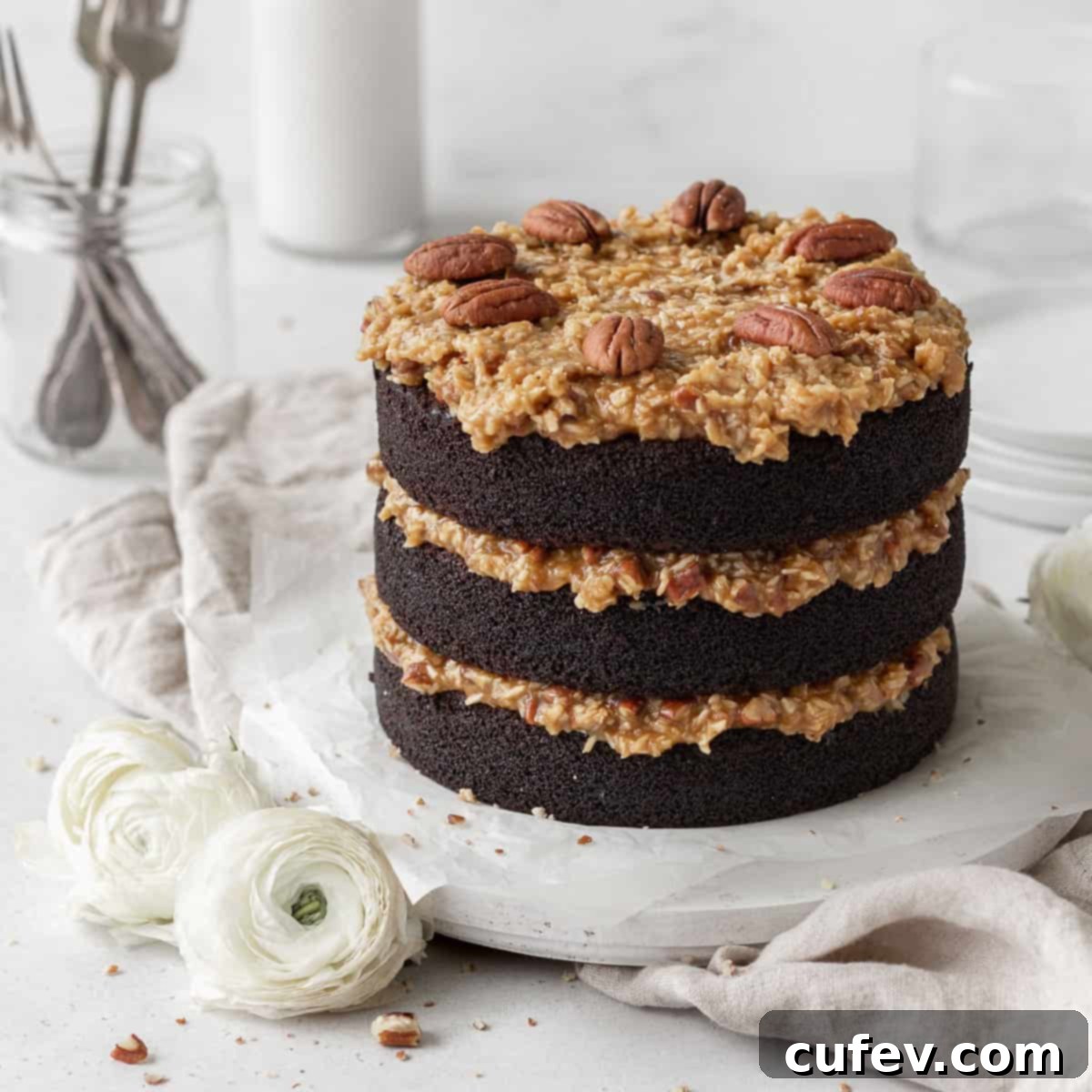Indulge in the Ultimate Gluten-Free & Dairy-Free German Chocolate Cake Recipe
Prepare to be enchanted by this incredible gluten-free German chocolate cake! It features luscious layers of incredibly moist chocolate cake perfectly complemented by a rich, decadent coconut pecan frosting. This isn’t just a dessert; it’s a celebration in every bite, proving that dietary restrictions don’t mean sacrificing flavor or texture. Whether you’re navigating allergies or simply seeking an extraordinarily delicious cake, this recipe delivers a showstopping experience that will impress everyone at your table.

This recipe was originally published on June 16, 2021. It was updated with new information and enhancements on February 23, 2024, to ensure the best possible baking experience.
Why This Gluten-Free German Chocolate Cake Will Become Your New Favorite
This isn’t just another cake recipe; it’s a carefully crafted delight designed to bring joy and satisfaction. Here’s why you’ll fall in love with this gluten-free and dairy-free German chocolate cake:
- Rich & Decadent Flavor Profile. Each layer of our chocolate cake boasts a deep, intense chocolate flavor that is perfectly balanced and not overly sweet. This provides an ideal contrast to the exquisitely rich and sweet coconut pecan frosting, creating a harmonious symphony of tastes that truly defines indulgence. You’ll savor the complexity without being overwhelmed.
- Unbeatable Texture. Prepare for a revelation in texture! The chocolate cake is incredibly fluffy and moist, so tender that you’d never guess it’s gluten-free. Between these soft, tender cake layers, you’ll discover generous blankets of our dreamy coconut pecan frosting. This unique frosting offers both a silky smoothness and a delightful crunch from the pecans, ensuring every mouthful is a captivating experience – truly a party in your mouth!
- Thoughtfully Allergen-Friendly. We understand the importance of inclusive baking. This German chocolate cake is meticulously crafted to be gluten-free, dairy-free, and soy-free, making it a perfect dessert option for those with common dietary restrictions. Now everyone can enjoy a slice of this classic without compromise.
- Easy, Yet Exceptionally Impressive. Looking for a dessert that demands attention but doesn’t require hours of intricate decorating? This is it! While the ingredient list might seem extensive, the assembly process is straightforward. The rustic charm of German chocolate frosting means there’s no need for perfectly smooth sides or fancy piping, making it an achievable “showstopper” even for intermediate bakers.
Essential Ingredients for Your Decadent Cake
While this recipe does call for a number of ingredients, each one plays a vital role in creating the deep flavors and perfect textures of this magnificent cake and its signature frosting. We promise the final result will be absolutely worth the effort! Here’s a detailed look at what you’ll need:
- Gluten-Free All-Purpose Flour: The foundation of our cake! It’s crucial to use a high-quality 1-to-1 baking blend that explicitly states it contains xanthan gum. This gum is essential for providing structure and elasticity to gluten-free baked goods, mimicking the role of gluten. Brands like Bob’s Red Mill 1-to-1 baking flour are excellent choices.
- Unsweetened Dutch-Processed Cocoa Powder: This is key for the cake’s deep, rich chocolate color and mellow, less bitter chocolate flavor. Dutch-processed cocoa has been treated to reduce its acidity, resulting in a darker hue and smoother taste compared to natural cocoa powder.
- Fine Salt: Don’t skip the salt! It’s not just for seasoning; it enhances all the other flavors, particularly the chocolate, and balances the sweetness. Fine salt dissolves easily into the batter.
- Baking Soda: This leavening agent reacts with acidic ingredients (like our apple cider vinegar and cocoa powder) to create carbon dioxide, which gives the cake its wonderful rise and fluffy texture.
- Baking Powder: Working alongside baking soda, baking powder provides additional lift and lightness to the cake, ensuring it’s beautifully airy and tender.
- Large Eggs: Eggs provide structure, moisture, and richness. This recipe strategically uses two large eggs in the cake batter for stability and three egg yolks in the frosting to create its signature creamy, custard-like base.
- Granulated Sugar: Provides a clean, sweet taste and helps tenderize the cake, contributing to its moist crumb.
- Brown Sugar: Adds a deeper, more complex sweetness with subtle molasses and toffee-like notes, enhancing both the cake and the frosting’s flavor profile. It also contributes to the cake’s moistness.
- Neutral-Flavored Oil: Such as avocado oil or a light olive oil. Using oil instead of solid fat helps keep the cake exceptionally moist and tender, and a neutral flavor ensures the chocolate truly shines.
- Non-Dairy Milk: Your choice of almond milk, oat milk, or soy milk will work beautifully. We’ll be transforming this into a non-dairy “buttermilk” for an extra tender crumb. (Remember to reserve 1 tablespoon for the buttermilk creation!)
- Apple Cider Vinegar: This acidic ingredient is crucial for reacting with the non-dairy milk to create a homemade non-dairy buttermilk, which is vital for the cake’s texture and for activating the baking soda.
- Hot Brewed Coffee: This is a secret ingredient for intense chocolate flavor! You won’t taste the coffee itself; instead, it deepens and amplifies the chocolate notes, making them more robust and irresistible.
- Vanilla Extract: Pure vanilla extract or vanilla paste adds a warm, aromatic depth that complements the chocolate and enhances the overall flavor of both the cake and frosting.
- Vegan Butter: Essential for adding rich, buttery flavor and a smooth texture to the iconic coconut pecan frosting, ensuring it tastes truly indulgent without any dairy.
- Non-Dairy Evaporated Milk: This ingredient is a cornerstone of traditional German chocolate cake frosting. It provides a unique richness, creaminess, and depth of flavor that is hard to replicate, giving the frosting its signature consistency.
- Unsweetened Coconut: You can use either shredded or desiccated coconut, but ensure it is unsweetened. This allows the natural sweetness of the frosting to come through and avoids an overly sugary result.
- Pecans: For the absolute best flavor and aroma, use freshly roasted and chopped pecans. Toasting them briefly brings out their natural oils and nutty essence, elevating the frosting significantly.
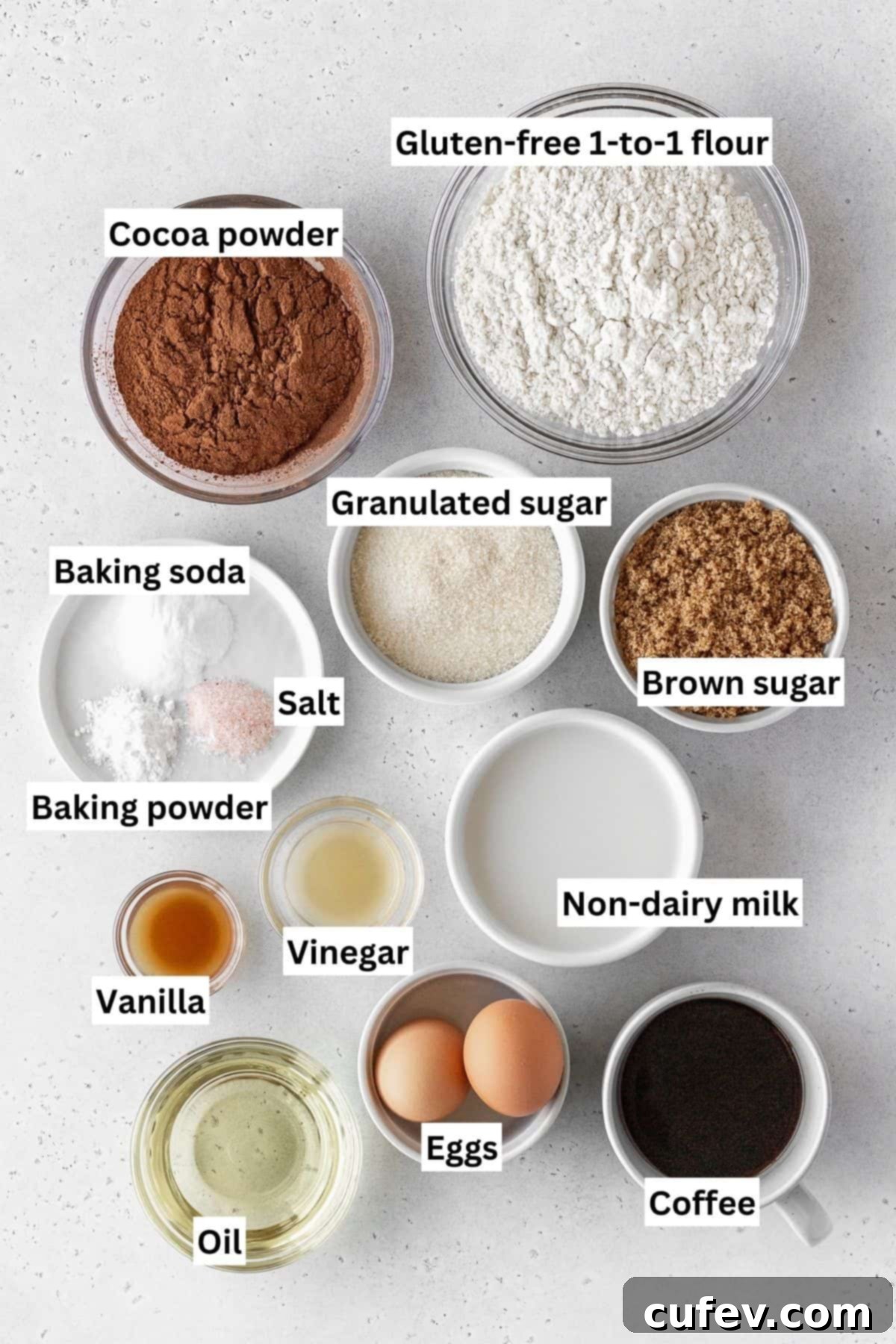
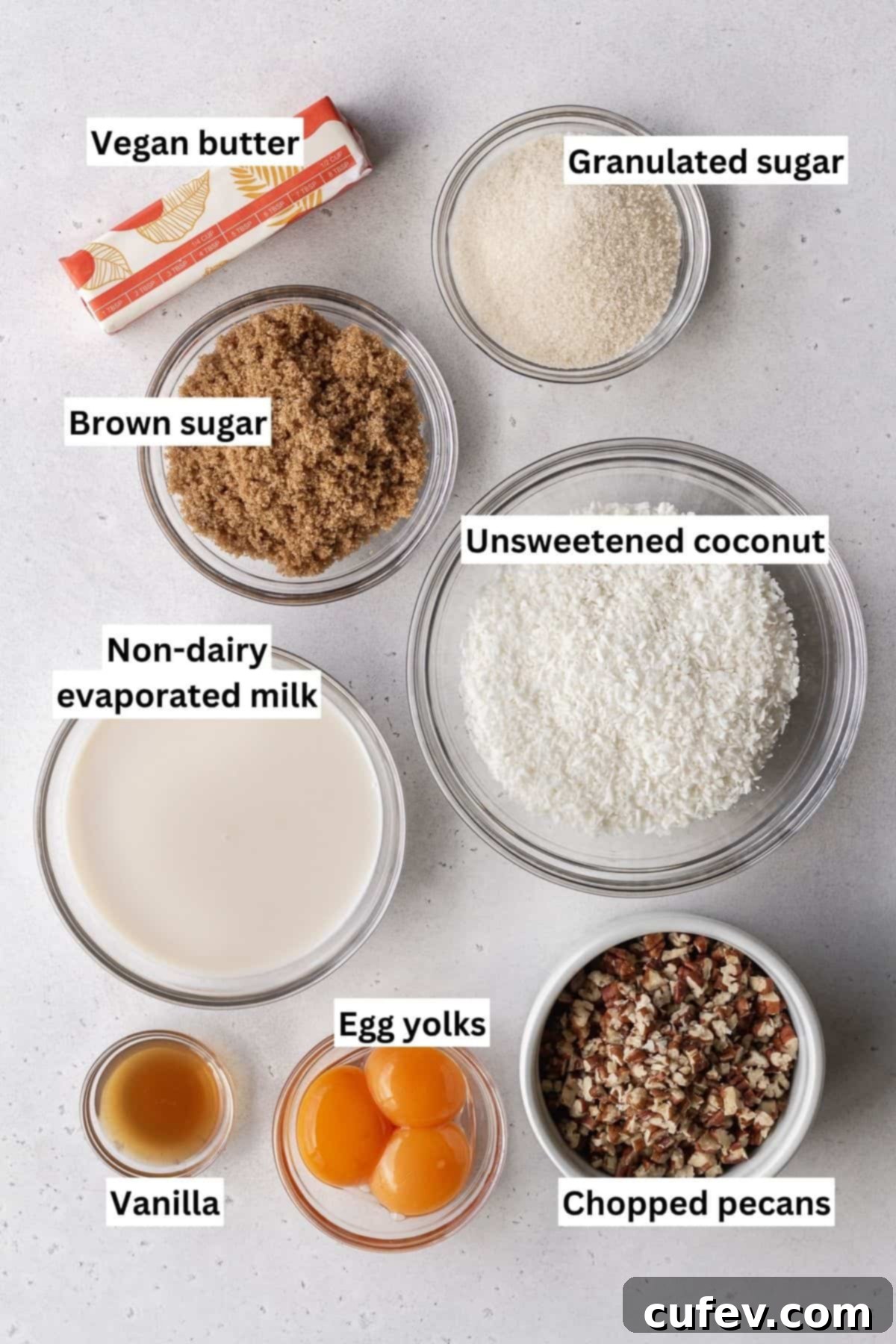
Helpful Ingredient Substitutions
We’ve designed this recipe to be as allergen-friendly as possible, but we understand that sometimes you might need to make adjustments based on what you have on hand or specific dietary needs. Here are some tested and recommended substitutions:
- Non-Dairy Milk: If you are not adhering to a dairy-free diet, you can absolutely use traditional buttermilk in place of the non-dairy milk and apple cider vinegar combination. Alternatively, if you don’t have buttermilk, you can create a simple substitute by mixing plain dairy yogurt and whole milk in a 1:1 ratio. Let it sit for 5-10 minutes to thicken slightly before using.
- Vegan Butter: For those who consume dairy, standard unsalted dairy butter can be used directly as a 1:1 substitute for vegan butter in the frosting. The rich flavor will be equally delightful.
- Non-Dairy Evaporated Milk: This can sometimes be tricky to find. But fear not, you have excellent options:
- Make Your Own Evaporated Milk: It’s surprisingly simple! Heat 1⅓ cups (approximately 400ml) of your chosen non-dairy milk in a saucepan over medium heat. Once it reaches a gentle boil, reduce the heat to low and simmer, stirring occasionally, until the liquid has reduced by about a quarter, leaving you with exactly 1 cup of concentrated, evaporated non-dairy milk. This process deepens its flavor and thickens its consistency.
- Canned Coconut Milk: An excellent and readily available alternative! Be sure to use full-fat coconut milk that comes in a can, not the thinner beverage-style coconut milk sold in cartons. The higher fat content of canned coconut milk is crucial for achieving the rich, creamy texture of the traditional German chocolate frosting.
- Coffee: While we highly recommend using hot brewed coffee to enhance the chocolate flavor without imparting a coffee taste, you can skip it if preferred. Simply use an equal amount of hot water instead. The cake will still be delicious, though with a slightly less intense chocolate depth.
- Eggs: While the recipe is formulated with eggs for optimal results, especially for structure in gluten-free baking and richness in the frosting, you might consider alternatives if omitting eggs.
- For the cake batter, while I haven’t personally tested it, a commercial gluten-free egg replacer like Bob’s Red Mill Egg Replacer would likely be the most successful option, following package directions.
- For the frosting, which relies on egg yolks for thickening, you could try adding one tablespoon of cornstarch mixed with a little cold water to create a slurry. Add this slurry to the saucepan along with the other ingredients to help thicken the mixture. Please note that texture and richness may vary slightly with egg-free substitutions.
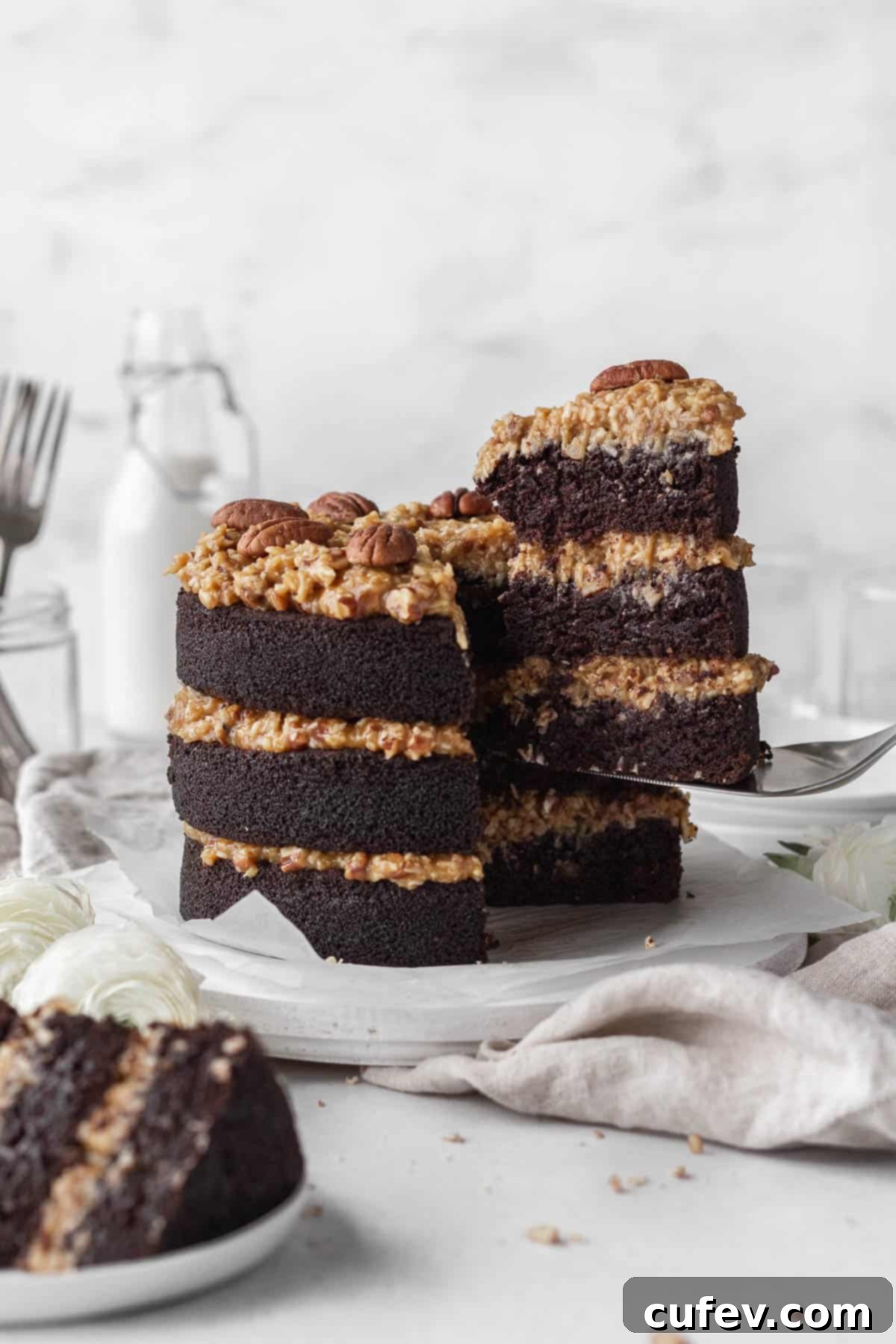
Step-by-Step: How To Make This Gluten-Free German Chocolate Cake
Creating this masterpiece is a rewarding process. Follow these detailed steps to achieve perfect, moist cake layers and that signature decadent frosting.
Crafting the Moist Chocolate Cake Layers
Step 1: Prepare the Non-Dairy Buttermilk. In a small bowl, combine your non-dairy milk and apple cider vinegar. Give it a gentle stir and let this mixture sit undisturbed for about 5-10 minutes. You’ll notice it will begin to curdle slightly; this is exactly what we want, as it activates the leavening agents for a tender cake.
Step 2: Sift Dry Ingredients. In a medium-sized bowl, use a fine-mesh sieve to sift together the gluten-free all-purpose flour, Dutch-processed cocoa powder, fine salt, baking soda, and baking powder. Sifting ensures there are no lumps and helps to aerate the flour, contributing to a lighter cake texture. Set this bowl aside.
Step 3: Combine Wet Ingredients. In a large mixing bowl, whisk together the large eggs, granulated sugar, brown sugar, neutral-flavored oil, the prepared non-dairy buttermilk mixture from Step 1, and vanilla extract until thoroughly combined and smooth.
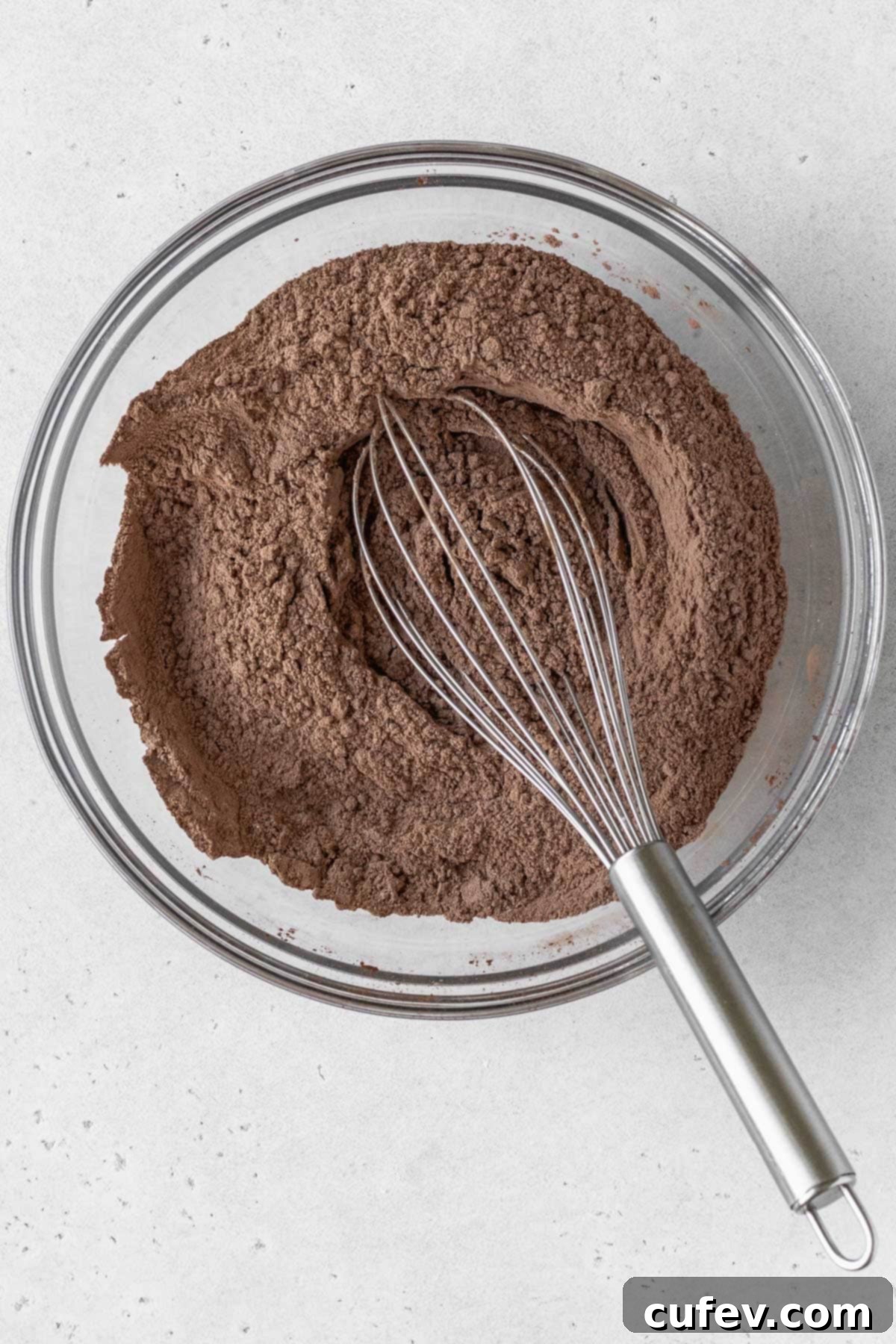

Step 4: Incorporate Dry to Wet, Then Add Coffee & Rest. Gradually add the sifted flour mixture into the wet ingredients. Mix on low speed or by hand until *just* combined; avoid overmixing, which can toughen gluten-free cakes. Pour in the hot brewed coffee and stir gently until a smooth, slightly thin batter forms. Cover the bowl with plastic wrap and let the batter rest at room temperature for a full 30 minutes. This resting period is vital for allowing the gluten-free flour to properly hydrate, ensuring a wonderfully moist cake.
Step 5: Prepare Baking Pans & Preheat Oven. While the cake batter rests, preheat your oven to 340°F (170°C). Generously grease and line the bottoms of three 6-inch round cake pans (or two 8-inch round pans if you prefer fewer, thicker layers) with parchment paper. Greasing and lining are crucial for easy cake release.
Step 6: Bake the Cake Layers. Evenly divide and pour the rested batter into the prepared cake pans. Bake for approximately 32-35 minutes. To check for doneness, a wooden skewer or toothpick inserted into the center should come out clean. Allow the cakes to cool in their pans for 10 minutes before carefully inverting them onto a wire cooling rack to cool completely. This prevents them from becoming soggy.
Step 7: Chill Cake Layers. Once the cake layers are completely cool to the touch, wrap each layer individually with plastic wrap. Place them in the refrigerator or freezer for at least an hour. Chilling makes the layers firmer and much easier to handle and level, especially with moist gluten-free cakes.
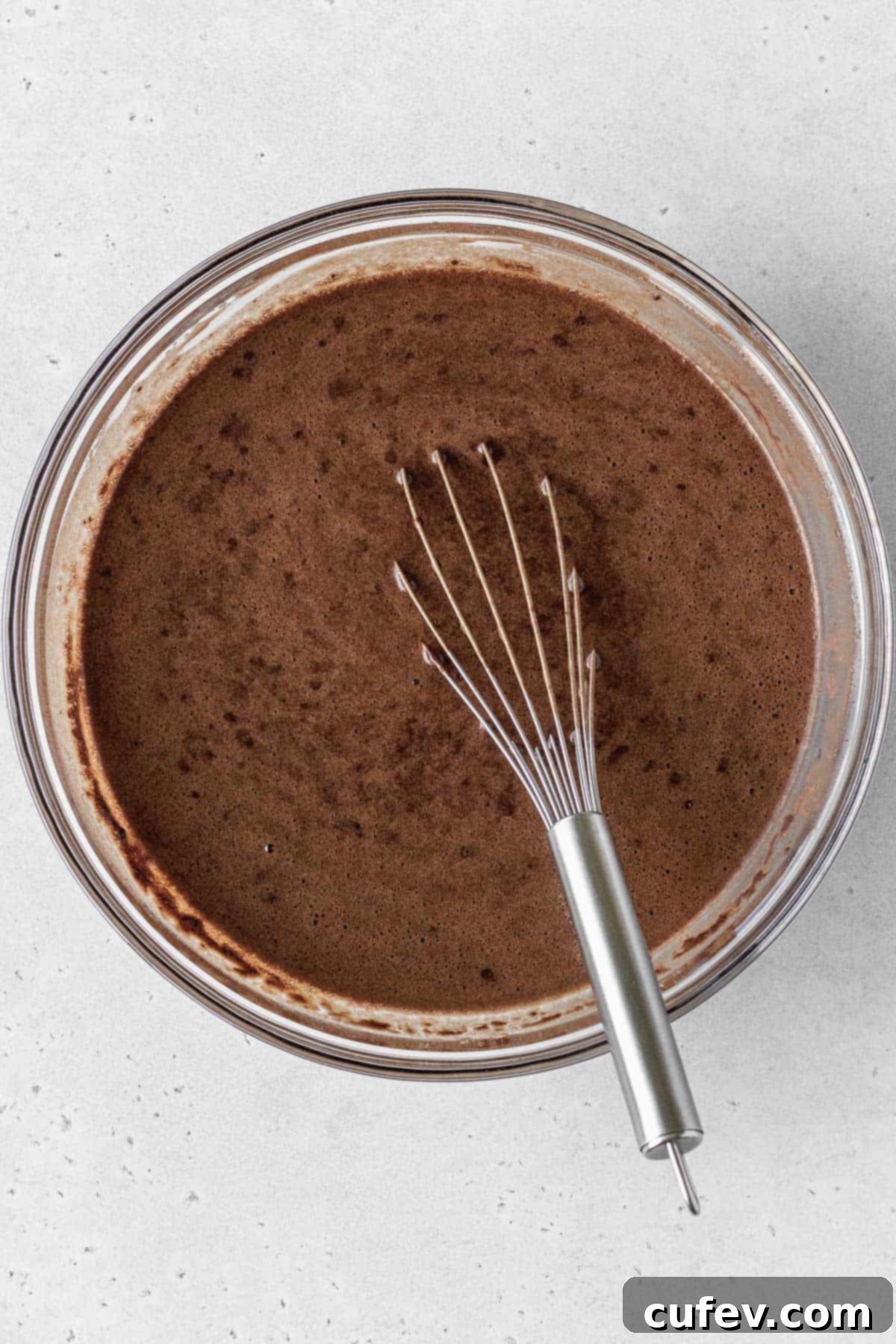

Preparing the Decadent German Chocolate Frosting
While your cake layers are chilling, it’s the perfect time to create the iconic coconut pecan frosting.
Step 1: Combine Frosting Base. In a sturdy saucepan, whisk together the egg yolks and non-dairy evaporated milk until smooth. Then, add the vegan butter (cut into pieces for easier melting), granulated sugar, brown sugar, vanilla extract, and a pinch of fine salt. The order is important here to prevent the sugar from “burning” the egg yolks.
Step 2: Cook the Frosting. Place the saucepan over medium heat, whisking constantly. Continue whisking as the mixture heats up and begins to thicken. Once it reaches a boil, continue to whisk vigorously for an additional 5 minutes. The mixture should become thick enough to coat the back of a spoon. This cooking process is crucial for thickening the frosting and ensuring food safety with the egg yolks.
Step 3: Add Coconut & Pecans, Then Chill. Remove the saucepan from the heat. Immediately stir in the unsweetened coconut and chopped pecans until well distributed. Allow the frosting mixture to cool completely at room temperature before transferring it to the refrigerator to chill for at least 30 minutes. Chilling will firm up the frosting to the perfect spreading consistency.

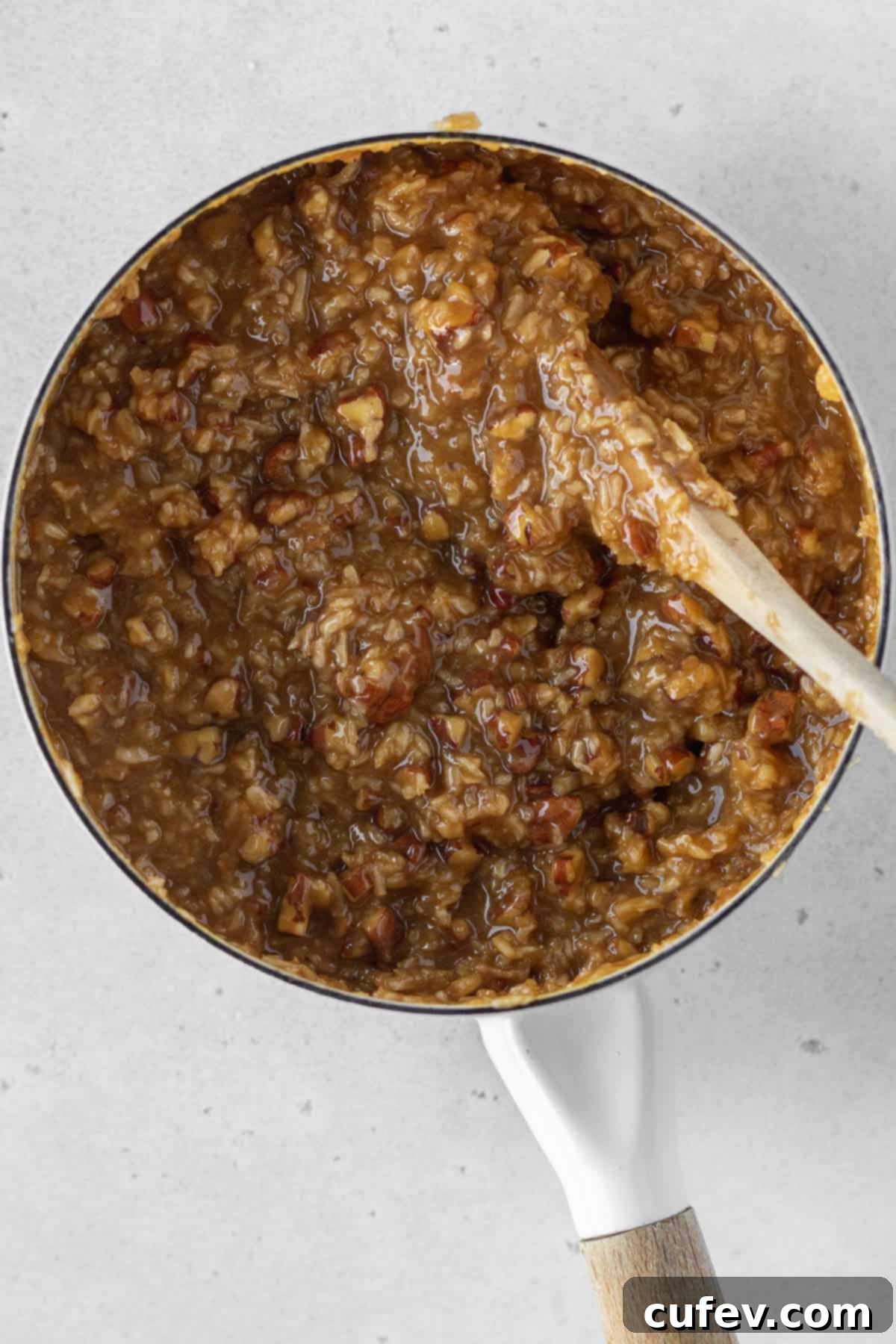
Assembling Your Showstopping German Chocolate Cake
With perfectly baked cake layers and luscious frosting ready, it’s time for the grand finale – assembly!
Step 1: Level the Cake Layers. Carefully unwrap your chilled cake layers. Using a sharp serrated knife or a cake leveler, slice off any domes from the top of each layer to create flat, even surfaces. This step is crucial for a stable and beautiful cake. Each layer should be approximately one inch tall.
Step 2: First Layer & Frosting. Place one leveled cake layer onto your chosen cake stand or serving plate. Scoop about one-third of the prepared coconut pecan frosting onto the center of the cake. Using an offset spatula, the back of a knife, or a spoon, gently spread the frosting evenly to the very edge of the cake layer.
Step 3: Stack & Repeat. Carefully place a second cake layer directly on top of the first, aligning it as best as possible. Add another third of the frosting and spread it out as before. Repeat this process with the final cake layer, ensuring the last third of the frosting covers the top of the cake. The beauty of German chocolate cake frosting is its rustic, textured appearance, so don’t worry about making the sides perfectly smooth!

Recipe Pro-Tips for Perfect Results
To ensure your gluten-free German chocolate cake turns out absolutely perfect, keep these expert tips in mind:
- Always Chill Cake Layers Before Leveling. Our gluten-free chocolate cake recipe yields an incredibly soft and moist crumb. While delicious, this tenderness can make slicing off the domes challenging and messy. Chilling the cakes, either in the refrigerator for at least an hour or in the freezer for 30 minutes, firms them up significantly, allowing for clean, even cuts.
- Achieve Even Layers with Precision. For a truly stunning and professional-looking cake, take the time to level your cake layers accurately. A ruler or a specialized cake leveler can be invaluable here. Even layers ensure a stable structure and a balanced frosting-to-cake ratio in every slice. When baked in 6-inch pans, each leveled layer should ideally measure about one inch in height.
- Introduce Frosting Ingredients Strategically. When making the frosting, avoid adding all ingredients into the saucepan simultaneously. Specifically, prevent the egg yolks from directly contacting granulated sugar before they’ve had a chance to mix with the evaporated milk. Sugar can rapidly draw moisture out of egg yolks, causing them to “burn” or scramble into hard clumps at the bottom of the pan, ruining the smooth texture of your frosting.
- Rescue “Burnt” Egg Yolks with an Immersion Blender. If, despite your best efforts, some sugar “burns” the egg yolks and you find small orange bits or clumps at the bottom of your saucepan, don’t despair! Before adding the coconut and pecans, use an immersion blender directly in the saucepan to thoroughly smooth out the mixture. This can often save your frosting from being discarded.
- Efficiently Time Cake Baking and Frosting Preparation. Maximize your baking efficiency by timing your steps. While your cake layers are cooling on the rack (after their initial 10 minutes in the pan), begin preparing your German chocolate frosting on the stovetop. Once both the cakes are completely cool and the frosting has been cooked, place both in the refrigerator to chill and thicken. This parallel process saves a significant amount of time.
- Ensure Even Frosting Distribution. To guarantee each layer of your cake receives an equal amount of that irresistible coconut pecan frosting, use an ice cream scoop or a measuring cup. Scoop out equal portions of frosting for each layer before spreading it gently and evenly to the edges of the cake. This method ensures visual appeal and consistent flavor throughout the cake.
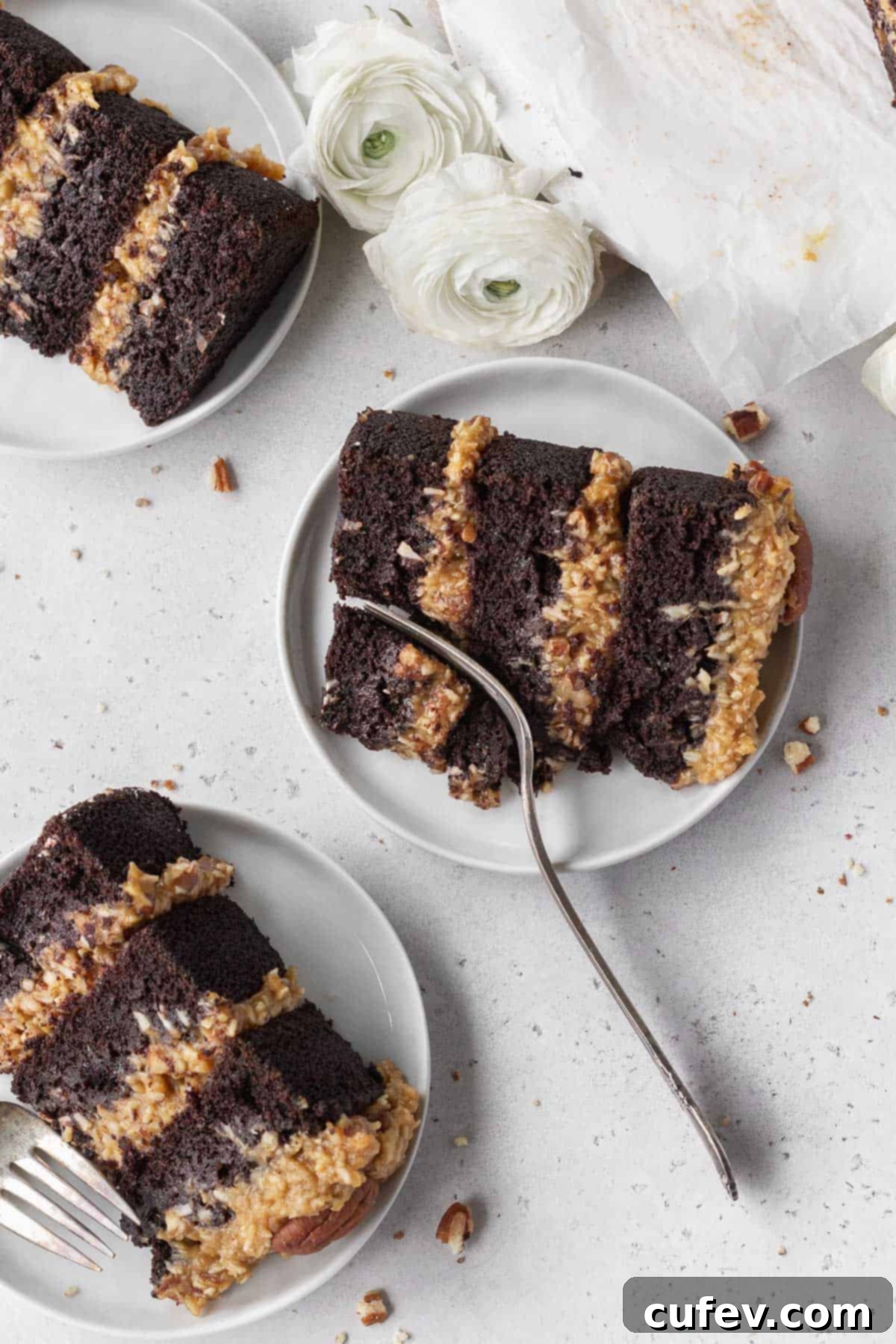
Storage Instructions for Freshness
To keep your delicious gluten-free German chocolate cake tasting its best for as long as possible, proper storage is key:
- Refrigerator: This German chocolate cake maintains its moistness and flavor beautifully when stored in the refrigerator for up to 3 to 4 days. If storing the whole cake, place it on a plate and cover it tightly with plastic wrap to prevent it from drying out or absorbing other food odors. For convenience, you can also slice the cake into individual servings and place them in an airtight container.
- Freezer: For longer storage, this cake freezes wonderfully for up to 3 months. To freeze, first cut the cake into individual slices. Wrap each slice meticulously with plastic wrap, ensuring it’s completely sealed, and then wrap it again with aluminum foil to provide an extra layer of protection against freezer burn. Place the double-wrapped slices in a freezer-safe bag or an airtight container before transferring them to the freezer. Thaw individual slices in the refrigerator overnight or at room temperature for a few hours before serving.
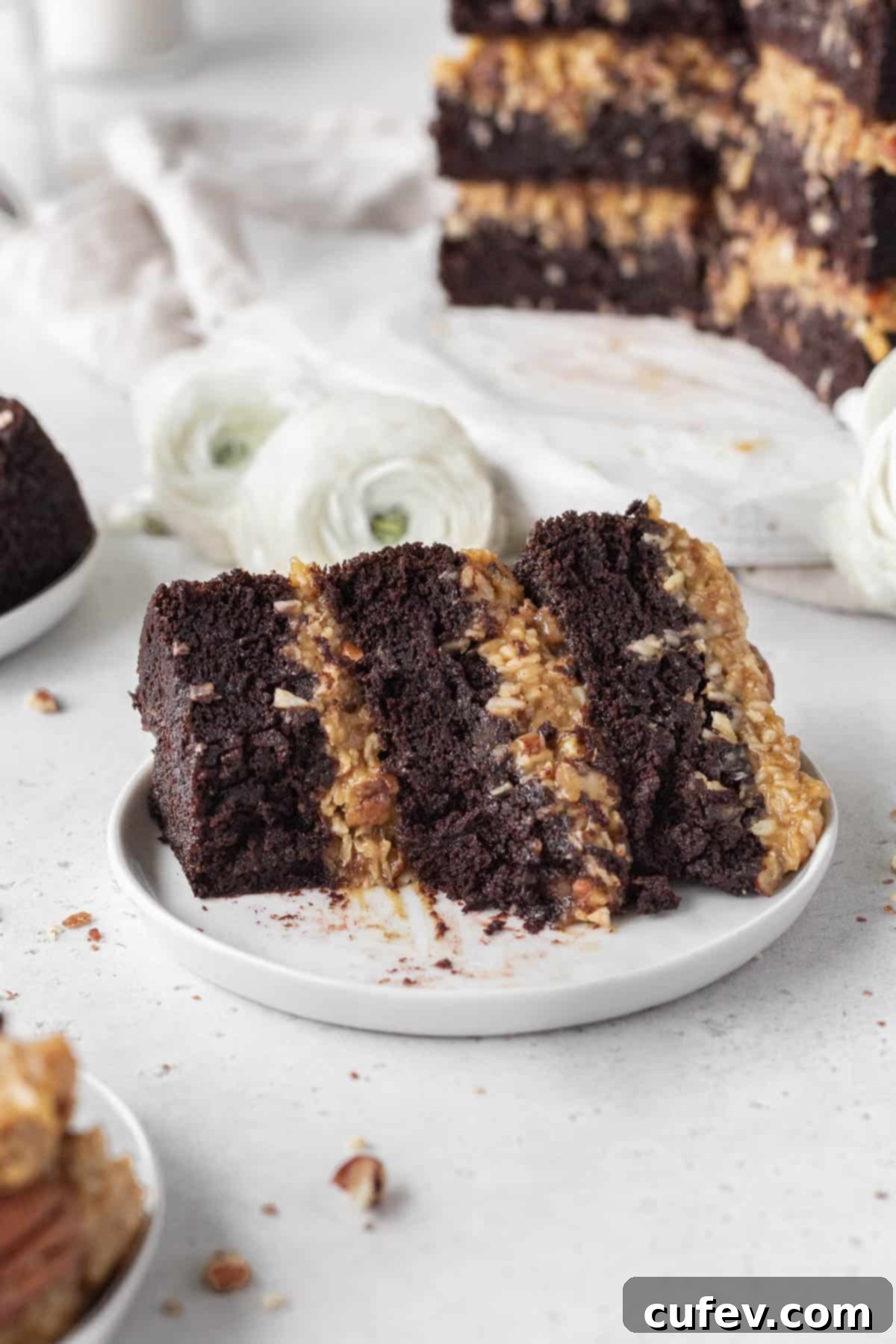
Frequently Asked Questions About German Chocolate Cake
German chocolate cake is distinctively known for its rich, custardy coconut and pecan frosting. Unlike typical chocolate cakes frosted with buttercream, this classic features layers of moist chocolate cake generously slathered with a thick, sweet, and nutty caramel-like frosting that incorporates shredded coconut and chopped pecans. This unique frosting gives it a signature texture and flavor that sets it apart from other chocolate desserts.
The iconic frosting on German chocolate cake is a luscious concoction traditionally made from a cooked mixture of butter, evaporated milk, granulated sugar, egg yolks, and vanilla. After cooking to a thick, creamy consistency, shredded coconut and chopped pecans are stirred in. This creates a uniquely rich, chewy, and crunchy topping that typically embraces a rustic, slightly uneven appearance, without the need for intricate piping or a smooth crumb coat – its charm lies in its homemade look!
Despite its name, German chocolate cake is not a German dessert in the traditional sense. It’s a classic American cake that originated in the Southern United States. The “German” in its name comes from Samuel German, an American baker who developed a type of dark baking chocolate for the Baker’s Chocolate Company in 1852. This product was initially called “German’s Sweet Chocolate.” The recipe gained widespread popularity when a Texan housewife named Mrs. George Clay submitted her recipe for “German’s Chocolate Cake” to a Dallas newspaper in 1957, utilizing Samuel German’s chocolate. The name simply refers to the brand of chocolate used, not the country of origin.
Absolutely! This cake is an excellent choice for making ahead. The cake layers can be baked, cooled, wrapped, and stored in the refrigerator for up to 3 days, or frozen for up to a month. The frosting can also be made a day or two in advance and stored in an airtight container in the refrigerator; simply give it a good stir before assembling. Assembling the cake a day before serving also allows the flavors to meld beautifully, often resulting in an even more delicious and moist cake.
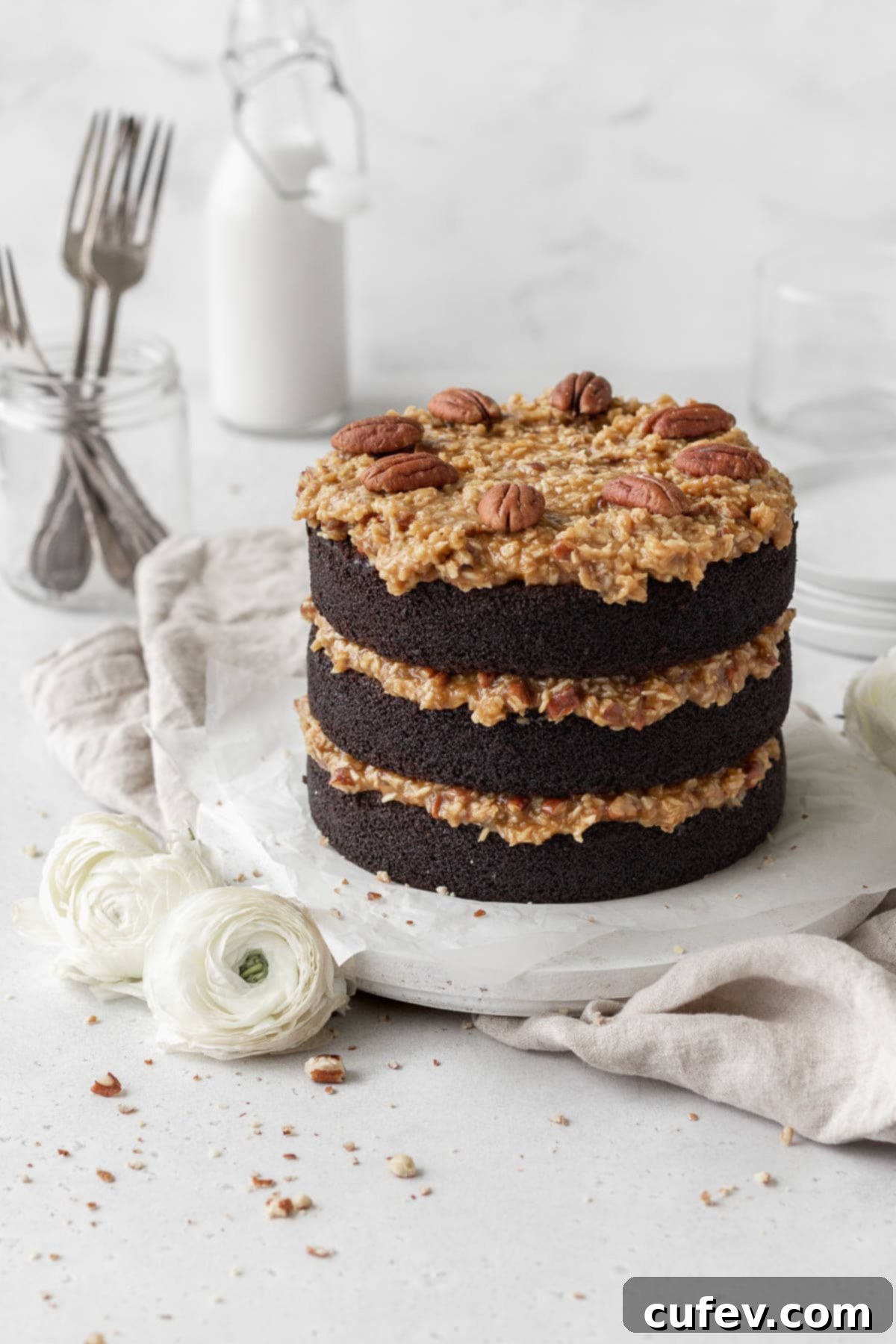
More Irresistible Chocolate Desserts to Explore
If you’ve fallen in love with this gluten-free German chocolate cake, you’ll definitely want to try some of these other delightful chocolate creations:
- For another fantastic chocolate layer cake experience, delve into my classic gluten-free chocolate cake, experiment with the fun textures of my chocolate cake with salty peanuts and pretzels, or wake up your taste buds with my rich chocolate mocha cake! Each one promises incredible moistness and flavor.
- If you’re more inclined towards individual treats, you absolutely must try my chocolate peanut butter cupcakes or my timeless moist chocolate cupcakes.
- For our vegan chocolate enthusiasts, these plant-based options are a must-make: enjoy the sweet and savory balance of these vegan salted caramel chocolate cupcakes or the delightful fruity twist of these vegan chocolate banana cupcakes!
- Not always in the mood for cake? No problem! Satisfy your chocolate cravings with some intensely fudgy gluten-free brownies or bake up a batch of my chewy, delightful double chocolate chip cookies instead!
I genuinely hope you loved creating and tasting this Gluten-Free German Chocolate Cake Recipe as much as I enjoyed sharing it with you. Don’t forget to follow me on Pinterest, Facebook, and Instagram for more delicious recipes and baking inspiration. You can also get all of my newest content and exclusive tips delivered straight to your inbox by signing up for my email newsletter!
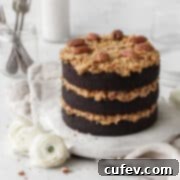
Gluten-Free German Chocolate Cake Recipe
Print
Pin
Rate
Ingredients
Chocolate cake
- 2 cups gluten-free 1-to-1 flour
- ¾ cup Dutch processed cocoa powder
- 1 teaspoon fine salt
- 2 teaspoons baking soda
- 1 teaspoon baking powder
- 2 large eggs
- 1 cup granulated sugar
- 1 cup brown sugar
- ½ cup oil
- 1 cup non-dairy milk (take out 1 tablespoon)
- 1 tablespoon apple cider vinegar
- 1 cup brewed coffee
- 2 teaspoons vanilla extract
Frosting
- 1 stick vegan butter
- ½ cup granulated sugar
- ½ cup brown sugar
- 3 egg yolks
- 1 cup non-dairy evaporated milk (see Notes)
- 2 teaspoons vanilla extract
- 1½ cups unsweetened coconut (shredded or desiccated)
- 1 cup chopped pecans
- ⅛ teaspoon fine salt
Instructions
Chocolate cake
-
In a small bowl, stir together non-dairy milk and apple cider vinegar. Let the mixture sit and curdle.
-
In a medium bowl, sift together flour, cocoa powder, salt, baking soda, and baking powder. Set it aside.
-
In a large bowl, combine the eggs, granulated sugar, brown sugar, oil, non-dairy milk mixture, and vanilla extract.
-
Add the flour mixture into the wet ingredients and mix until just combined. Pour in the hot coffee and stir again until a smooth mixture forms. Cover the bowl and let the batter rest for 30 minutes.
-
While the batter rests, preheat the oven to 340°F (170°C) and grease and line three 6-inch round pans (or two 8-inch round pans) with parchment paper.
-
Evenly pour the batter into the cake pans and bake for 32-35 minutes. Let the cakes cool in the pan for 10 minutes before taking them out onto a cooling rack to let them cool completely.
-
Once cooled, wrap each layer with plastic and put it in the fridge or freezer for an hour.
Frosting
-
In a saucepan, mix together egg yolks and evaporated milk. Add butter, granulated sugar, brown sugar, vanilla, and salt.
-
Heat it on medium heat while whisking constantly. Once it reaches a boil, continue to whisk for 5 minutes.
-
Take it off the heat and add the coconut and pecans. Let it cool completely before putting it in the refrigerator for 30 minutes.
Assembly
-
Slice the domes off of the chilled cake layers to make them flat and even. Each layer should be about an inch tall.
-
Place one cake layer on a cake stand or plate. Put a third of the frosting on the cake and spread it to the edge using an offset spatula, knife, or spoon.
-
Place another cake layer on top and spread another third of the frosting on top. Repeat once more, finishing with frosting on top.
Notes
Evaporated milk substitute: Canned coconut milk! Make sure it’s the kind that comes in a can, as it’s thicker.
